Motorcycle Investor mag
Subscribe to our free email news
Ducati 750 GT
(by Ian Falloon, July 2022)

Trend-setting
twin
In the 1970s motorcycles were
simple and individual. This was the era before
electronic fuel injection or even electronic ignition.
Points ignition, carburettors, and air-cooling ruled.
Because most bikes were unfaired the engine was visually
dominant, generally fours or parallel twins, but if you
liked V-twins there was really only one contender,
Ducati’s 750 GT.
In 1971 Ducati was a minor
Italian manufacturer known primarily for producing
smaller capacity overhead camshaft singles. But everyone
wanted a Superbike and Ducati was no exception.

Without the resources to
create a three or four cylinder Superbike Ducati’s chief
engineer Fabio Taglioni (at right in the pic above) was
asked to design a pragmatic 750. He took two existing
350cc singles and placed them on a common crankcase with
the cylinders 90-degrees apart.
As an engineering purist,
Taglioni chose the 90-degree layout for several reasons.
He preferred 90-degrees because it offered perfect
primary engine balance and with this layout the engine
could be very smooth, with only some high frequency
secondary imbalance. Also, theoretically the twin could
be little wider than a single so the engine could be
kept low in the frame while maintaining good ground
clearance.
Taglioni called it an L-twin,
and established the trademark engine layout that has
been associated with Ducati ever since.

With 30mm carbs and low
compression 8.5:1 pistons the 750 GT provided only
moderate performance but it was the way the engine
performed that was appealing. The power delivery was
smooth and effortless, the engine relaxed and loping,
even when running close to the 8000rpm redline. And
there was a lot more to the 750 Ducati than the engine.
The handling was class
leading. Taglioni eschewed the almost universal double
cradle Norton “Featherbed” style frame in favour of an
open cradle design using the engine as a stressed
member. While other Superbikes featured forks with
skinny and flexible 35mm tubes the Ducati had a beefy
38mm fork.
Those bikes in the early
1970s with disc brakes mostly had stainless steel rotors
and floating piston brake calipers. The stainless discs
didn’t rust but they didn’t work in the rain either.
Rusty discs didn’t worry Ducati. They wanted the brakes
to work every time so they fitted a cast-iron disc rotor
with a racing style twin piston caliper that gripped the
disc from both sides.
Taglioni also knew the
benefit of minimising unsprung weight, fitting the 750
GT with beautiful Borrani alloy rims, a 19-inch on the
front and 18-inch on the rear. The weight was only 185kg
and the 750 GT was one of the lightest Superbikes
available.
The engine layout dictated a
very long 1530mm wheelbase, and with an extreme steering
rake of 29 degrees the Ducati 750 provided unparalleled
stability. This played dividends in 1972 when Taglioni
took a batch off the production line to prepare racing
machines for the Imola 200.
On 23 April ,1972, the 750
Ducati humbled the world’s best, including Agostini and
the MV Agusta and the finest Norton, Triumph, Kawasaki,
Honda, BMW, Suzuki and Moto Guzzi could offer. It was
the beginning of a new era for Ducati and the rest is
history.
This third series Ducati 750
GT is now fifty years old.
1971-72 750 GT Third
Series
Engine Number 750405-751500
Frame Number 750405-751800
approx
October 1971-June 1972
Ed’s
note: Ian has custom-published a new edition of his
750 GT bible. Contact him direct via email
for more info.

-------------------------------------------------
Produced by AllMoto abn 61 400 694 722
Privacy: we do not collect cookies or any other data.

Archives
Contact





